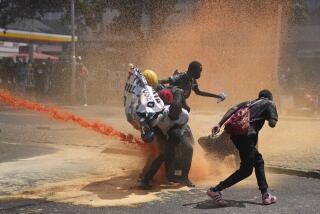Kenya’s conflict isn’t ‘tribal’
- Share via
I first started working in Kenya when conducting research for my master’s degree in 1991 at the University of Nairobi. It was a time of great hope and excitement. With the fall of the Berlin Wall, we saw a resurgence of democracy’s “third wave,” and it seemed that all of Africa was preparing for elections. That year, then-President Daniel T. Arap Moi legalized multi-partyism. Surprisingly, the most common word wasn’t “freedom” or even “participation” but rather “Majimboism.” Moi used this Kiswahili word for tribalism as a rallying cry to spread fear that tribal identities would come to dominate the political party system. It was a self-fulfilling prophesy. As democratic competition increased throughout the 1990s, two things happened: The opposition split and re-split until it was untenable, and Moi successfully manipulated institutions and the electoral code so that he could win the Statehouse with a relatively small minority of the vote twice.
The Times has reported that conflict in Kenya today is tribal. But the roots of conflict aren’t tribal. They aren’t even ethnic. They are pseudo-ethnic. A “tribe” in Africa is a particular identity construction created by colonial powers in an effort to more easily dominate the population. An ethnicity is a group of people who share a common identity, rituals and, most commonly, language. There are ethnic differences in Kenya, however constructed, but they are commonly trumped by kinship, class, labor, religion and even geographic identities. Ethnic identity has been manipulated by self-serving political elites.
This becomes clear when we remember that reprisals against Luos in their home province of Nyanza for attacks against Kikuyus are more often by Kalenjins than Kikuyus. Raila Odinga, the Luo opposition candidate, represents the Kibera slums of Nairobi, not the Luo home of Nyanza province. Attacks by Luos are commonly not Luo at all but rather Mungiki (a quasi-religious group comprised of militant young Kikuyu men nominally combating modernity). Most of the killings have not been committed by any ethnic group at all but rather government troops seeking to ensure that the Odinga’s opposition doesn’t rise to a social movement that could lead to President Mwai Kibaki’s ouster. The Times reported on the “roaming gangs” hunting for foreskin without recognizing that far from “tribal violence,” it is also committed by Mungiki, not just Kikuyu youth, and is derived from the politicization of circumcision by the government in the run up to the election.
In recent days, some scholars have pointed to weak institutions as a cause of violence. Surely there is a point here strong institutions would obviate the need for a civic maelstrom. Other scholars have pointed to predatory agents. Indeed, pseudo-ethnic identities are a negative consequence of democratization. Presidents and opposition leaders alike have transfixed certain parts of ethnic identity to suit their political ends. Others point to unresolved class and land issues. Those streaming into Nairobi city center from Kibera are not just Luo, but they are all poor. Kikuyu have been economically advantaged since the British and were the largest inheritor of land as white farmers fled at independence. Land redistribution is a pressing issue that has galvanized Kibera youth born to a lost future, including Luos, Kalenjin and Masai.
No doubt, given the diversity of conflict in place and groups, violence in Kenya reflects a combination of these issues. What is clear is this: There is a real cause for concern that hitherto stable Kenya could melt down particularly as the conflict has recently spread to the oft-marginal and well-mobilized Swahili coast. The solution doesn’t rely on calming primordial cleavages. It lies in the international community applying enough pressure on Kibaki to rectify the ill-fated elections and re-institutionalize the process; Odinga agreeing to a new political course; and the ability of both leaders to create incentives to recap the can of worms they opened by encouraging a social movement.
The conflict in Kenya is neither tribal nor ethnic at root. The unwillingness of much of the media to probe further is at minimum a collective anomie and at maximum an embedded racism reporting all African conflicts as if they were derived from a monolithic cause, constant across the diverse continent.
Richard R. Marcus is an assistant professor of International Studies at CSU Long Beach who has conducted research in Africa, including elite interviews in Nairobi from 2005-2007 and public opinion survey in Kenya’s Tana River district. While the opinions here are his own, they were formed with the intellectual assistance of his colleagues at the University of Nairobi.
More to Read
A cure for the common opinion
Get thought-provoking perspectives with our weekly newsletter.
You may occasionally receive promotional content from the Los Angeles Times.









